Jaewook Lee
Comparison of Optimised Geometric Deep Learning Architectures, over Varying Toxicological Assay Data Environments
Jul 22, 2025Abstract:Geometric deep learning is an emerging technique in Artificial Intelligence (AI) driven cheminformatics, however the unique implications of different Graph Neural Network (GNN) architectures are poorly explored, for this space. This study compared performances of Graph Convolutional Networks (GCNs), Graph Attention Networks (GATs) and Graph Isomorphism Networks (GINs), applied to 7 different toxicological assay datasets of varying data abundance and endpoint, to perform binary classification of assay activation. Following pre-processing of molecular graphs, enforcement of class-balance and stratification of all datasets across 5 folds, Bayesian optimisations were carried out, for each GNN applied to each assay dataset (resulting in 21 unique Bayesian optimisations). Optimised GNNs performed at Area Under the Curve (AUC) scores ranging from 0.728-0.849 (averaged across all folds), naturally varying between specific assays and GNNs. GINs were found to consistently outperform GCNs and GATs, for the top 5 of 7 most data-abundant toxicological assays. GATs however significantly outperformed over the remaining 2 most data-scarce assays. This indicates that GINs are a more optimal architecture for data-abundant environments, whereas GATs are a more optimal architecture for data-scarce environments. Subsequent analysis of the explored higher-dimensional hyperparameter spaces, as well as optimised hyperparameter states, found that GCNs and GATs reached measurably closer optimised states with each other, compared to GINs, further indicating the unique nature of GINs as a GNN algorithm.
Fine-Tuning and Prompt Engineering of LLMs, for the Creation of Multi-Agent AI for Addressing Sustainable Protein Production Challenges
Jun 25, 2025Abstract:The global demand for sustainable protein sources has accelerated the need for intelligent tools that can rapidly process and synthesise domain-specific scientific knowledge. In this study, we present a proof-of-concept multi-agent Artificial Intelligence (AI) framework designed to support sustainable protein production research, with an initial focus on microbial protein sources. Our Retrieval-Augmented Generation (RAG)-oriented system consists of two GPT-based LLM agents: (1) a literature search agent that retrieves relevant scientific literature on microbial protein production for a specified microbial strain, and (2) an information extraction agent that processes the retrieved content to extract relevant biological and chemical information. Two parallel methodologies, fine-tuning and prompt engineering, were explored for agent optimisation. Both methods demonstrated effectiveness at improving the performance of the information extraction agent in terms of transformer-based cosine similarity scores between obtained and ideal outputs. Mean cosine similarity scores were increased by up to 25%, while universally reaching mean scores of $\geq 0.89$ against ideal output text. Fine-tuning overall improved the mean scores to a greater extent (consistently of $\geq 0.94$) compared to prompt engineering, although lower statistical uncertainties were observed with the latter approach. A user interface was developed and published for enabling the use of the multi-agent AI system, alongside preliminary exploration of additional chemical safety-based search capabilities
Safeguarding Privacy of Retrieval Data against Membership Inference Attacks: Is This Query Too Close to Home?
May 28, 2025Abstract:Retrieval-augmented generation (RAG) mitigates the hallucination problem in large language models (LLMs) and has proven effective for specific, personalized applications. However, passing private retrieved documents directly to LLMs introduces vulnerability to membership inference attacks (MIAs), which try to determine whether the target datum exists in the private external database or not. Based on the insight that MIA queries typically exhibit high similarity to only one target document, we introduce Mirabel, a similarity-based MIA detection framework designed for the RAG system. With the proposed Mirabel, we show that simple detect-and-hide strategies can successfully obfuscate attackers, maintain data utility, and remain system-agnostic. We experimentally prove its detection and defense against various state-of-the-art MIA methods and its adaptability to existing private RAG systems.
From Text to Visuals: Using LLMs to Generate Math Diagrams with Vector Graphics
Mar 10, 2025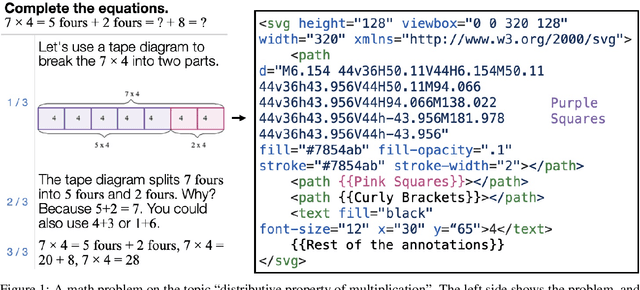


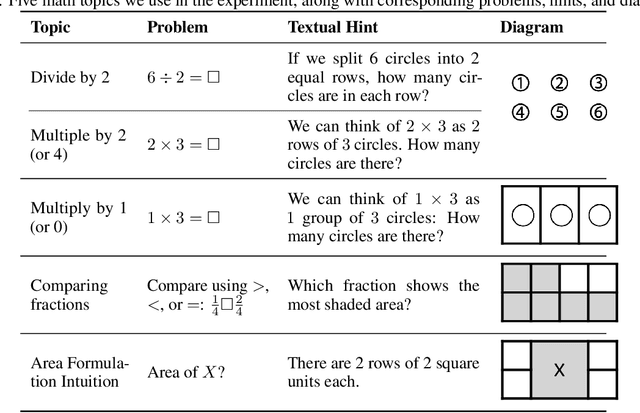
Abstract:Advances in large language models (LLMs) offer new possibilities for enhancing math education by automating support for both teachers and students. While prior work has focused on generating math problems and high-quality distractors, the role of visualization in math learning remains under-explored. Diagrams are essential for mathematical thinking and problem-solving, yet manually creating them is time-consuming and requires domain-specific expertise, limiting scalability. Recent research on using LLMs to generate Scalable Vector Graphics (SVG) presents a promising approach to automating diagram creation. Unlike pixel-based images, SVGs represent geometric figures using XML, allowing seamless scaling and adaptability. Educational platforms such as Khan Academy and IXL already use SVGs to display math problems and hints. In this paper, we explore the use of LLMs to generate math-related diagrams that accompany textual hints via intermediate SVG representations. We address three research questions: (1) how to automatically generate math diagrams in problem-solving hints and evaluate their quality, (2) whether SVG is an effective intermediate representation for math diagrams, and (3) what prompting strategies and formats are required for LLMs to generate accurate SVG-based diagrams. Our contributions include defining the task of automatically generating SVG-based diagrams for math hints, developing an LLM prompting-based pipeline, and identifying key strategies for improving diagram generation. Additionally, we introduce a Visual Question Answering-based evaluation setup and conduct ablation studies to assess different pipeline variations. By automating the math diagram creation, we aim to provide students and teachers with accurate, conceptually relevant visual aids that enhance problem-solving and learning experiences.
Training LLM-based Tutors to Improve Student Learning Outcomes in Dialogues
Mar 09, 2025



Abstract:Generative artificial intelligence (AI) has the potential to scale up personalized tutoring through large language models (LLMs). Recent AI tutors are adapted for the tutoring task by training or prompting LLMs to follow effective pedagogical principles, though they are not trained to maximize student learning throughout the course of a dialogue. Therefore, they may engage with students in a suboptimal way. We address this limitation by introducing an approach to train LLMs to generate tutor utterances that maximize the likelihood of student correctness, while still encouraging the model to follow good pedagogical practice. Specifically, we generate a set of candidate tutor utterances and score them using (1) an LLM-based student model to predict the chance of correct student responses and (2) a pedagogical rubric evaluated by GPT-4o. We then use the resulting data to train an open-source LLM, Llama 3.1 8B, using direct preference optimization. We show that tutor utterances generated by our model lead to significantly higher chances of correct student responses while maintaining the pedagogical quality of GPT-4o. We also conduct qualitative analyses and a human evaluation to demonstrate that our model generates high quality tutor utterances.
CoME: An Unlearning-based Approach to Conflict-free Model Editing
Feb 20, 2025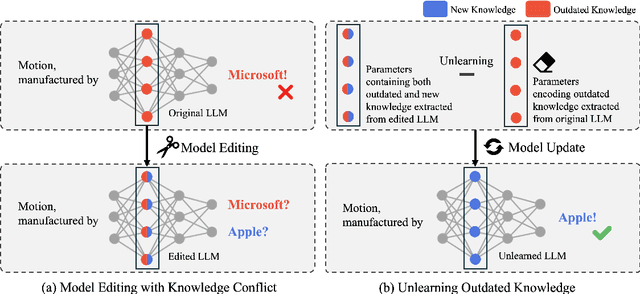


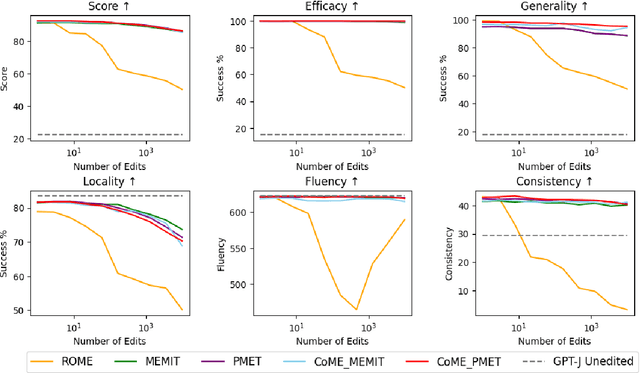
Abstract:Large language models (LLMs) often retain outdated or incorrect information from pre-training, which undermines their reliability. While model editing methods have been developed to address such errors without full re-training, they frequently suffer from knowledge conflicts, where outdated information interferes with new knowledge. In this work, we propose Conflict-free Model Editing (CoME), a novel framework that enhances the accuracy of knowledge updates in LLMs by selectively removing outdated knowledge. CoME leverages unlearning to mitigate knowledge interference, allowing new information to be integrated without compromising relevant linguistic features. Through experiments on GPT-J and LLaMA-3 using Counterfact and ZsRE datasets, we demonstrate that CoME improves both editing accuracy and model reliability when applied to existing editing methods. Our results highlight that the targeted removal of outdated knowledge is crucial for enhancing model editing effectiveness and maintaining the model's generative performance.
Leveraging Programmatically Generated Synthetic Data for Differentially Private Diffusion Training
Dec 13, 2024Abstract:Programmatically generated synthetic data has been used in differential private training for classification to enhance performance without privacy leakage. However, as the synthetic data is generated from a random process, the distribution of real data and the synthetic data are distinguishable and difficult to transfer. Therefore, the model trained with the synthetic data generates unrealistic random images, raising challenges to adapt the synthetic data for generative models. In this work, we propose DP-SynGen, which leverages programmatically generated synthetic data in diffusion models to address this challenge. By exploiting the three stages of diffusion models(coarse, context, and cleaning) we identify stages where synthetic data can be effectively utilized. We theoretically and empirically verified that cleaning and coarse stages can be trained without private data, replacing them with synthetic data to reduce the privacy budget. The experimental results show that DP-SynGen improves the quality of generative data by mitigating the negative impact of privacy-induced noise on the generation process.
BayesNAM: Leveraging Inconsistency for Reliable Explanations
Nov 10, 2024Abstract:Neural additive model (NAM) is a recently proposed explainable artificial intelligence (XAI) method that utilizes neural network-based architectures. Given the advantages of neural networks, NAMs provide intuitive explanations for their predictions with high model performance. In this paper, we analyze a critical yet overlooked phenomenon: NAMs often produce inconsistent explanations, even when using the same architecture and dataset. Traditionally, such inconsistencies have been viewed as issues to be resolved. However, we argue instead that these inconsistencies can provide valuable explanations within the given data model. Through a simple theoretical framework, we demonstrate that these inconsistencies are not mere artifacts but emerge naturally in datasets with multiple important features. To effectively leverage this information, we introduce a novel framework, Bayesian Neural Additive Model (BayesNAM), which integrates Bayesian neural networks and feature dropout, with theoretical proof demonstrating that feature dropout effectively captures model inconsistencies. Our experiments demonstrate that BayesNAM effectively reveals potential problems such as insufficient data or structural limitations of the model, providing more reliable explanations and potential remedies.
A KAN-based Interpretable Framework for Process-Informed Prediction of Global Warming Potential
Nov 01, 2024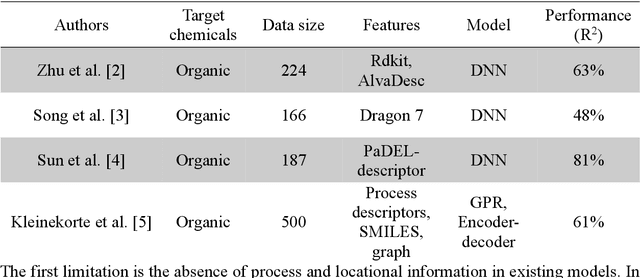
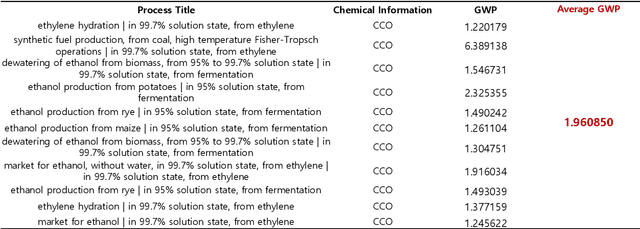
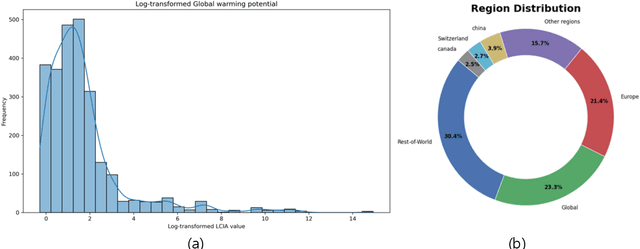

Abstract:Accurate prediction of Global Warming Potential (GWP) is essential for assessing the environmental impact of chemical processes and materials. Traditional GWP prediction models rely predominantly on molecular structure, overlooking critical process-related information. In this study, we present an integrative GWP prediction model that combines molecular descriptors (MACCS keys and Mordred descriptors) with process information (process title, description, and location) to improve predictive accuracy and interpretability. Using a deep neural network (DNN) model, we achieved an R-squared of 86% on test data with Mordred descriptors, process location, and description information, representing a 25% improvement over the previous benchmark of 61%; XAI analysis further highlighted the significant role of process title embeddings in enhancing model predictions. To enhance interpretability, we employed a Kolmogorov-Arnold Network (KAN) to derive a symbolic formula for GWP prediction, capturing key molecular and process features and providing a transparent, interpretable alternative to black-box models, enabling users to gain insights into the molecular and process factors influencing GWP. Error analysis showed that the model performs reliably in densely populated data ranges, with increased uncertainty for higher GWP values. This analysis allows users to manage prediction uncertainty effectively, supporting data-driven decision-making in chemical and process design. Our results suggest that integrating both molecular and process-level information in GWP prediction models yields substantial gains in accuracy and interpretability, offering a valuable tool for sustainability assessments. Future work may extend this approach to additional environmental impact categories and refine the model to further enhance its predictive reliability.
Gaussian Process Regression-Based Lithium-Ion Battery End-of-Life Prediction Model under Various Operating Conditions
Oct 25, 2024Abstract:For the efficient and safe use of lithium-ion batteries, diagnosing their current state and predicting future states are crucial. Although there exist many models for the prediction of battery cycle life, they typically have very complex input structures, making it very difficult and expensive to develop such models. As an alternative, in this work, a model that predicts the nominal end-of-life using only operating conditions as input is proposed. Specifically, a total of 100 battery degradation data were generated using a pseudo two-dimensional model with three major operating conditions: charging C-rate, ambient temperature and depth-of-discharge. Then, a Gaussian process regression-based model was developed to predict the nominal end-of-life using these operating conditions as the inputs. To improve the model accuracy, novel kernels were proposed, which are tailored to each operating condition. The proposed kernels reduced the lifetime prediction error by 46.62% compared to the conventional kernels.
 Add to Chrome
Add to Chrome Add to Firefox
Add to Firefox Add to Edge
Add to Edge